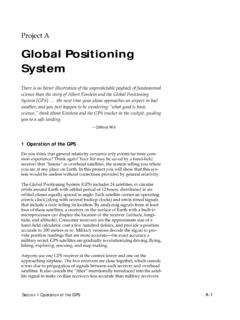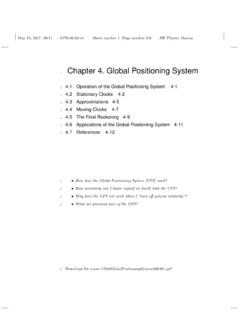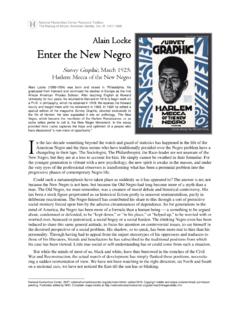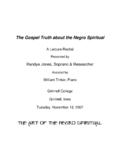Transcription of The Spinning Black Hole - Edwin F. Taylor
1 Section 1 Introduction F-1 PROJECT F The Spinning Black hole Black holes are macroscopic objects with masses varying from a few solar masses to millions of solar masses. To the extent they may be considered as stationary and isolated, to that extent, they are all, every single one of them, described exactly by the Kerr solution. This is the only instance we have of an exact description of a macroscopic object. Macroscopic objects, as we see them all around us, are governed by a variety of forces, derived from a variety of approximations to a variety of physical theories. In contrast, the only elements in the construction of Black holes are our basic concepts of space and time. They are, thus, almost by definition, the most perfect macroscopic objects there are in the universe. And since the general theory of relativity provides a single unique two-parameter family of solutions for their description, they are the simplest objects as well.
2 S. Chandrasekhar 1 Introduction In this project we explore some of the properties of spacetime near a spin-ning Black hole . Analogous properties describe spacetime external to the surface of the Spinning Earth, Sun, or other Spinning uncharged heavenly body. For a Black hole these properties are truly remarkable. Near enough to a Spinning Black hole even outside its horizon you cannot resist being swept along tangentially in the direction of rotation. You can have a negative total energy. From outside the horizon you can, in principle, har-ness the rotational energy of the Black Spinning Black holes exist? The primary question is: Do Black holes exist? If the answer is yes, then Spinning Black holes are inevitable, since astronomical bodies most often rotate. As evidence, consider the most compact stellar object short of a Black hole , the neutron star. Detection of radio and X-ray pulses from some Spinning neutron stars (called pulsars ) tells us that many neutron stars rotate, some of them very rapidly.
3 These are impressive structures, with more mass than our Sun, some of them Spinning once every few milliseconds. Conclusion: If Black holes exist, then Spinning Black holes relativity predicts that when an isolated Spinning star collapses to a Black hole , gravitational radiation quickly (in a few seconds of far-away time!) smooths any irregularities in rotation. Thereafter the metric exterior F-2 P ROJECT F The Spinning Black hole to the horizon of the Spinning Black hole will be the Kerr metric used in this project. However, not all Spinning Black holes are isolated; many are surrounded by other matter attracted to them. The inward-swirling mass of a resulting accretion disk can affect spacetime in its vicinity, distorting the metric away from that of the isolated Spinning Black hole that we analyze here. 2 Angular Momentum of the Black hole An isolated Spinning uncharged Black hole is completely specified by just two quantities: its mass M and its angular momentum.
4 In Chapter 4 (page4-3) we defined the angular momentum per unit mass for a particle orbit-ing a nonspinning Black hole as L/m = r 2 d / d . In this expression, the angle has no units and proper time has the unit meter. Therefore L/m has the unit meter. To avoid confusion, the angular momentum of a spin-ning Black hole of mass M is given the symbol J and its angular momentum per unit mass is written J/M . The ratio J/M appears so often in the analysis that it is given its own symbol: a = J/M . We call the constant a the angular momentum parameter . Just as the angular momentum L/m of a stone orbiting a non-rotating Black hole has the unit meter, so does the angular momentum parameter a = J/M have the unit meter. In what follows it is usually sufficient to treat the angular momentum parameter a as a positive scalar and others found the metric for a Spinning Black hole with net electric charge (see references in Section 14 and also equation [51] for the metric of a charged nonspinning Black hole ).
5 The most general steady-state Black hole has mass, angular momentum, and electric charge. However, we have no evidence that astronomical bodies carry sufficient net electric charge (which would ordinarily be rapidly neutralized) to affect the met-ric. If actual Black holes are uncharged, then the Kerr metric describes the most general stable isolated Black hole likely to exist in Nature. 3 The Kerr Metric in the Equatorial Plane For simplicity we are going to study spacetime and particle motion in the equatorial plane of a symmetric Spinning Black hole of angular momen-tum J and mass M . The equatorial plane is the plane through the center of the Spinning Black hole and perpendicular to the spin axis. Here is the Kerr metric in the equatorial plane, expressed in what are called Boyer-Lindquist coordinates . The angular momentum parameter a = J/M appears in a few unaccustomed places.[1] d 212Mr-------- dt24 Mar-----------dtd dr212Mr-------- a2r2-----+------------------------------ 1a2r2-----2Ma2r3--------------++ r2d 2 += Section 3 The Kerr Metric in the Equatorial Plane F-3 For the nonrotating Black hole examined in Chapters 2 through 5, the Schwarzschild metric describing spacetime on a plane is the same for any plane that cuts through the center of the Black hole , since the Schwarz-schild Black hole is spherically symmetric.
6 The situation is quite different for the Spinning Kerr Black hole ; the metric [1] is correct only for neighbor-ing events that occur in the plane passing through the center of the Black hole and perpendicular to its axis of rotation. We choose the equatorial plane because it leads to the simplest and most interesting time t in equation [1] is the far-away time registered on clocks far from the center of attraction, just as for the Schwarzschild metric. In con-trast, for a > 0 the Boyer-Lindquist r -coordinate does not have the simple geometrical meaning that it had for the Schwarzschild metric. More on the meaning of r in Sections 4 and 9. The metric [1] provides a complete description of spacetime in the equatorial plane outside the horizon of a Spinning uncharged Black hole . No additional information is needed to answer every possible question about its (nonquantum) properties and (with the Principle of Extremal Aging) about orbits of free particles and light pulses in the equatorial plane.
7 You say that the Kerr metric provides a complete nonquantum description of the spin-ning Black hole . Why this reservation? What more do we need to know to apply general relativity to quantum phenomena? In answer, listen to Stephen Hawking as he discusses the singularity of spacetime at the beginning of the Universe. A similar comment applies to the singularity inside any Black hole . Suggestion: As you go along, check the units of all equations, the equations in the project and also your own derived equations. An equation can be wrong if the units are right, but the equation cannot be right if the units are wrong!The general theory of relativity is what is called a classical theory. That is, it does not take into account the fact that particles do not have precisely defined positions and velocities but are smeared out over a small region by the uncertainty principle of quantum mechanics that does not allow us to measure simultaneously both the position and the velocity.
8 This does not matter in normal situations, because the radius of curvature of space-time is very large compared to the uncertainty in the position of a particle. However, the singularity theorems indicate that space-time will be highly distorted, with a small radius of curvature at the beginning of the present expansion phase of the universe [or at the center of a Black hole ]. In this situation, the uncertainty principle will be very important. Thus, general relativity brings about its own downfall by predicting singularities. In order to discuss the beginning of the universe [or the center of a Black hole ], we need a theory that combines general relativity with quantum mechanics. Stephen Hawking F-4 P ROJECT F The Spinning Black hole The Kerr metric has four central new features that distinguish it from the Schwarzschild metric. The first new feature of the Kerr metric is a new r -value for the horizon . In the Schwarzschild metric, the coefficient of dr 2 is 1/(1 2M/r ).
9 This coef-ficient increases without limit at the Schwarzschild horizon, r H = 2 M . For the Kerr metric, in contrast, the horizon the point of no return has an r -value that depends on the value of the angular momentum parameter a. (Note: A true proof that a horizon exists requires the demonstration that worldlines can run through it only in the inward direction, not outward. For the corresponding proof for the non- Spinning Black hole , see Project B, pages B-14 15. Our choice here of the horizon at the place where the coef-ficient of dr 2 blows up is an intuitive, but yet correct, selection.)QUERY 1 Equatorial-plane Kerr metric in the limit of zero angular momentum. Show that for zero angular momentum (a = J/M = 0), the Kerr metric, equation [1], reduces to the Schwarzschild metric (equation [A] in Selected Formulas at the end of this book).QUERY 2 Motion stays in plane. Make an argument from symmetry that a free object that begins to orbit a Spinning Black hole in the equatorial plane will stay in the equatorial Spinning Black Holes Power Quasars?
10 In contrast to dead solitary Black holes, the most powerful steady source of energy we know or conceive or see in all the universe may be powered by a Spinning Black hole of many millions of solar masses, gulping down enormous amounts of matter swirling around it. Maarten Schmidt, working at the Palomar Mountain Observatory in 1956, was the first to uncover evidence for these quasi-stellar objects, or quasars, starlike sources of light located not bil-lions of kilometers but billions of light-years away. Despite being far smaller than any galaxy, the typical quasar man-ages to put out more than a hundred times as much energy as our entire Milky Way with its hundred billion stars. Quasars unsurpassed in brilliance and remoteness can justly be called lighthouses of the and theory have come together to explain in broad outline how a quasar operates. A Spinning Black hole of some hundreds of millions of solar masses, itself perhaps built by accretion, accretes more mass from its surroundings.








